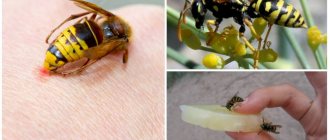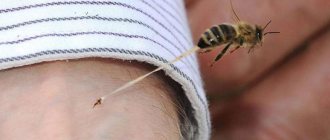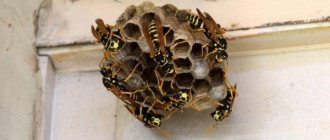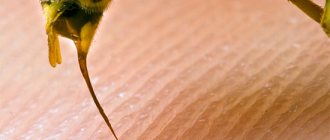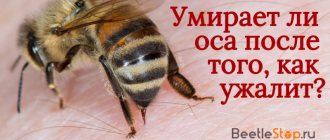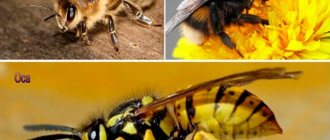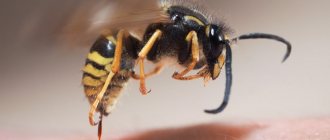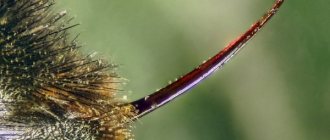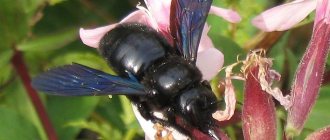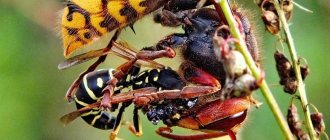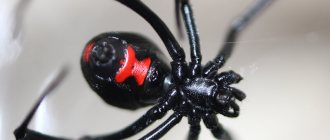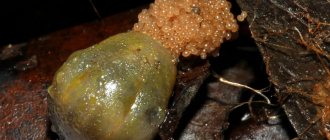Who, when attacked, leaves a sting in the wound, bees or wasps. What you need to know about these amazing insects. Benefit or harm to humans. Why they sting people, the reasons for the attack and how to avoid the attack. First aid for a victim of a bee or wasp sting.
We all know insects such as bees and wasps well. We also know that they can sting very painfully. When using stings, they release toxic poison, which in some cases poses a huge danger to human health.
Some representatives leave a sting in the wound after a bite. Next, we will take a detailed look at these insects, learn about their characteristics, and also figure out which of them leaves a sting and why this happens.
The structure of the wasp sting and the degree of toxicity of the poison
The sting of a wasp looks like a sharp, thin needle. Upon closer inspection, you can see that the organ consists of two stylets, separated by a canal that is connected to the venom gland. In a calm state, the sting is located in the abdomen, where it is protected by special plates. Before the wasp stings, the sharp weapon is pulled out with the help of muscles, moving along a sled.
The composition, and therefore the toxicity of the poison, largely depends on the species of the stung insect. The most dangerous are the Asian giant hornets. But the bite of Scolia, despite its large size and threatening appearance, does not threaten human health. Considering that only female wasps have a sting, a meeting with a male is unlikely to be dangerous.
wasp sting
Functions of the sting and features of bee venom
Bees initially had no sting and appeared in the process of evolution. Since this is a modified ovipositor, only females have it. A bee's sting looks like a sharp dark needle. If you look at it under a microscope, you can see numerous notches covering the surface.
The main purpose of the sting is to protect the life of the bee, its home and the lives of other family members. The structure of the sting makes it easier to insert it into the victim’s body and inject poison from a special reservoir.
Difference between the sting of a worker bee and a queen bee
Of those who have a sting in a bee colony, in addition to worker bees, it is necessary to mention the queen. Since the queen, unlike sterile workers, uses the ovipositor for its intended purpose - to lay eggs, it is better developed and longer than that of ordinary bees. In addition, the queen's sting has only 3 serrations, so she can easily pull it out even from soft tissues.
Bee sting
Lifestyle
Bee leafcutter
Bees have a very developed sense of hierarchy and family. Workers can work around the clock to provide for the hive, and in search of nectar they can travel many kilometers. They collect flower nectar, process it and produce a large number of products used in medicine and cooking. They build honeycombs from wax, which they produce themselves.
Wasps build their homes from scrap materials and various waste materials. Their diet is devoid of sophistication; they can eat small midges, carrion of birds and animals, but they also eat fruits (including rotten ones) and nectar. Due to the fact that wasps often browse landfills in search of food, they sometimes become carriers of infections. Predatory wasps also kill living insects and inject poison that paralyzes the victim.
How does a bee sting?
The bee sting process occurs in several stages:
- The insect comes into contact with the surface of the enemy's skin. Under the influence of the abdominal muscles, the tip of the sting, hidden in the abdomen, is directed to the exit hole.
- The bee's stinger extends outward and the insect plunges it into the skin of the victim.
- When the tool sinks at least a third, the bee can no longer pull it out; the notches interfere with this. After the insect stings, it tries to fly away, resulting in part of the abdomen being torn off.
Despite the fact that the bee has already flown away, the poison continues to enter the stung person’s body for some time through the sting remaining in the skin.
Behavior
Bees are friendly insects; they don’t just attack. They can only sting to protect their home. In this case, after the attack, the bee will die, leaving its sting in the human body. Her aggression has only one goal - to save the womb, as the highest creature in their family hierarchy. In a dangerous situation, the signal to mobilize quickly reaches the entire flock from one bee, so a swarm immediately flies against the aggressor.
How long does a bee live?
The wasp often stings for no reason. It sticks to a person, circles around him, can bite completely spontaneously, and does not die after the attack. After the wasp comes into view, you need to stop, freeze, and not wave your arms. The wasp does not attack a motionless person. She doesn't need allies to attack.
Important! In addition to the sting, the wasp uses its jaws for attack. Wasps do not have the instinct to preserve the queen for reproduction. In addition, wasp queens are loners. They independently build nests and bear offspring.
Does a bee leave a sting when it stings?
Taking into account the external similarity of insects, for many people the question remains open: who leaves the sting - a wasp or a bee. The bee's sting is saw-shaped due to numerous barbs radiating from the sharp end to the base, like a fishhook. It is these notches that prevent the sting from being removed after it penetrates the skin.
Trying to fly away, the insect twitches and tears out from its body not only the sting, but also part of the abdomen with a sac of poison and internal organs.
Appearance
Both species of stinging insects belong to the order Hymenoptera. It is not possible to determine who is bigger at first glance. Bees appear thicker due to their thick hairs. You can tell a wasp from a bee by their appearance.
The main difference is the color:
- Bee color: the body is painted in a more modest yellow tone, intersected by blurry dark stripes. Paws are dark in color. The body is rounded, covered with thick hairs, and the girdle between parts of the body is almost invisible. The abdomen differs in shape, depending on its role in the hive. In workers who collect nectar, it is ovoid. In queens it is oblong. The drones have a body that seems to be truncated and larger than that of an ordinary inhabitant of the hive. The bee's legs are equipped with baskets for storing flower nectar and pollen.
- The wasp looks more elegant. Its abdomen, head and paws are smooth, painted in a deep yellow color, which is clearly separated by a dark pattern. And the abdomen and chest are sharply separated by a narrow belt. The body is elongated. During examination, you can distinguish strong jaws and thin legs.
How to properly remove a sting?
When helping a person after an insect bite, the first step is to carefully examine the wound and remove the sting. If in the case of wasps this action is most often skipped, since the sting rarely remains in the skin, then in the case of a bee sting, the sting must be pulled out as quickly as possible, since while it is in the skin, poison continues to enter the body.
You must act confidently and carefully. The most convenient way is to use tweezers. They grab the sting at the base and pull it towards themselves. If you don’t have tweezers, a needle will do, which should act in the same way as when removing a splinter. Under no circumstances should you try to squeeze out the sting. This will provoke a more active spread of the poison.
Removal
After the sharp instrument is removed, the wound is washed and treated with a disinfectant. A cold compress is applied to relieve swelling.
Potentially dangerous situations
Adults behave calmly, confidently and consistently in potentially dangerous situations. That's why they are adults. But children are prone to panic and lack of control. Especially if the bee stung you in the eye or face.
When a bee stings your eye
A bee stung in the eye: what to do
If a bee stings your eye, then you will definitely have to seek medical help from the nearest medical facility, since this problem cannot be solved on your own. The eyelids around the eyes will become very swollen, obscuring vision. Plus, complications such as conjunctivitis, inflammation of the eyelids, or purulent inflammation of the eyeball may develop.
Calling an ambulance in this case is the only right decision. It is better not to wait for complications to begin, but to immediately call an ambulance or go to the nearest hospital yourself. Doctors will quickly relieve swelling and give you an antihistamine.
What to do if a bee stings a child
Children are more difficult to tolerate insect bites. Not only is the child’s body more susceptible to various poisons and toxins, but the child’s reaction is also difficult to control.
What is important:
- First of all, try to calm the child down. At such moments it is difficult to do this, but it is worth trying.
- Make sure that the child does not scratch the sting site, and try to pull out the bee sting yourself.
- Treat the wound with antiseptic agents.
- Apply something cold. This will help relieve some of the pain and inflammation.
- Give an antihistamine.
- Call a doctor or take your child to the nearest health center.
Do all bees sting?
Not all bees are capable of stinging. Drones have a physiological obstacle - they do not have a stinger. Since this is a modified ovipositor, which is not provided by nature for male bees. Yes, and not every bee with a stinger can sting.
On a note! Working individuals, whose crops are filled with honey, are not able to bend their abdomen at the required angle in order to extend the sting and put it to work.
Experienced beekeepers can protect themselves by artificially creating a situation in which the bee fills the crop with honey. Bees perceive fumigation of the hive as an alarm signal. Fleeing from the fire, they gather supplies so as not to starve until new housing is found.
Causes of wasp and bee stings
Despite the fact that wasps are considered much more aggressive insects than bees, neither one nor the other almost never attacks people without a reason. They may attack if they feel threatened or are defending the nest.
Factors provoking insect attacks:
- sudden movements made near them;
- an attempt to stir up or destroy the home of insects;
- some odors (alcohol, perfume, sweat);
- colors are too bright or dark;
- loose hair, fur elements on clothes.
Nest
Another reason for bee attacks is the smell of fresh poison. If an insect stings, then there is a high probability that its relatives will soon appear. With wasps the situation is somewhat different. Sensing danger, they release a special alarm pheromone, which attracts nearby wasps.
What to do to protect yourself from insect attacks
There are a few simple rules that will help you protect yourself and prevent painful wasp and bee stings.
- If you encounter these insects, remember not to make sudden movements, as this will scare them, which means they will have to defend themselves. You should also not drive away, wave your arms, or try to drive away an insect that has landed on your clothing or your body. They are most likely attracted by the smell and want to explore the area, after which they will leave you alone and fly away.
- When walking in nature, especially in meadows where there are many flowers, do not walk barefoot. Very often there are many stinging insects in the grass.
- We all love to eat outdoors; on our table there are often aromatic fruits and sweet drinks; wasps and bees also like such treats, so when they hear the smell, they will definitely come to visit. Therefore, at the table you need to carefully watch the food you put in your mouth, and also, before drinking a sweet drink, look to see if there are any “guests” there.
- It’s better not to walk around with your hair down in nature; the fact is that insects very often get entangled in such “nets.” If you try to straighten the hair where it is, a bite will follow, because without realizing it, they will think that they are in danger.
- There is no need to give preference to too bright colors in clothes that attract them. They will also be attracted by the floral aroma of perfumes and some odors of decorative cosmetics; they should be as careful as possible.
- If you are driving a car with an open window and a bee or wasp flies in, there is no need to try to drive it out. Just stop and open all the windows, she will fly out of such a trap with great joy.
Differences between a wasp sting and a bee sting
Both bees and wasps have well-developed jaws. However, when we talk about a human bite, we mean a sting. When attacking people, these insects very rarely use their jaws; usually the sting acts as a weapon.
It is quite difficult to distinguish from the first sensations which insect has stung. It is believed that a wasp sting is more painful, but, firstly, the intensity of pain can only be compared if a person was stung by both insects at the same time. And secondly, perception depends on the individual characteristics of a person, age and type of insect, so it is definitely wrong to give the palm to someone else.
It is also not easy to determine which stinging insect attacked from the symptoms. The signs of a bite are the same - burning pain, redness of the skin, swelling. The only true difference is the presence of a sting in the wound; in a bee it always comes off, unlike a wasp.
